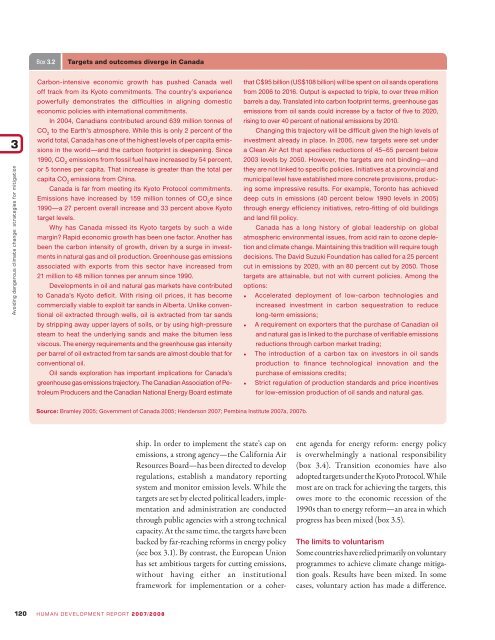The 21st Century climate challenge
The 21st Century climate challenge
The 21st Century climate challenge
You also want an ePaper? Increase the reach of your titles
YUMPU automatically turns print PDFs into web optimized ePapers that Google loves.
Box 3.2Targets and outcomes diverge in Canada3Avoiding dangerous <strong>climate</strong> change: strategies for mitigationCarbon-intensive economic growth has pushed Canada welloff track from its Kyoto commitments. <strong>The</strong> country’s experiencepowerfully demonstrates the diffi culties in aligning domesticeconomic policies with international commitments.In 2004, Canadians contributed around 639 million tonnes ofCO 2to the Earth’s atmosphere. While this is only 2 percent of theworld total, Canada has one of the highest levels of per capita emissionsin the world—and the carbon footprint is deepening. Since1990, CO 2emissions from fossil fuel have increased by 54 percent,or 5 tonnes per capita. That increase is greater than the total percapita CO 2emissions from China.Canada is far from meeting its Kyoto Protocol commitments.Emissions have increased by 159 million tonnes of CO 2e since1990—a 27 percent overall increase and 33 percent above Kyototarget levels.Why has Canada missed its Kyoto targets by such a widemargin? Rapid economic growth has been one factor. Another hasbeen the carbon intensity of growth, driven by a surge in investmentsin natural gas and oil production. Greenhouse gas emissionsassociated with exports from this sector have increased from21 million to 48 million tonnes per annum since 1990.Developments in oil and natural gas markets have contributedto Canada’s Kyoto defi cit. With rising oil prices, it has becomecommercially viable to exploit tar sands in Alberta. Unlike conventionaloil extracted through wells, oil is extracted from tar sandsby stripping away upper layers of soils, or by using high-pressuresteam to heat the underlying sands and make the bitumen lessviscous. <strong>The</strong> energy requirements and the greenhouse gas intensityper barrel of oil extracted from tar sands are almost double that forconventional oil.Oil sands exploration has important implications for Canada’sgreenhouse gas emissions trajectory. <strong>The</strong> Canadian Association of PetroleumProducers and the Canadian National Energy Board estimatethat C$95 billion (US$108 billion) will be spent on oil sands operationsfrom 2006 to 2016. Output is expected to triple, to over three millionbarrels a day. Translated into carbon footprint terms, greenhouse gasemissions from oil sands could increase by a factor of five to 2020,rising to over 40 percent of national emissions by 2010.Changing this trajectory will be difficult given the high levels ofinvestment already in place. In 2006, new targets were set undera Clean Air Act that specifies reductions of 45–65 percent below2003 levels by 2050. However, the targets are not binding—andthey are not linked to specific policies. Initiatives at a provincial andmunicipal level have established more concrete provisions, producingsome impressive results. For example, Toronto has achieveddeep cuts in emissions (40 percent below 1990 levels in 2005)through energy effi ciency initiatives, retro-fi tting of old buildingsand land fill policy.Canada has a long history of global leadership on globalatmospheric environmental issues, from acid rain to ozone depletionand <strong>climate</strong> change. Maintaining this tradition will require toughdecisions. <strong>The</strong> David Suzuki Foundation has called for a 25 percentcut in emissions by 2020, with an 80 percent cut by 2050. Thosetargets are attainable, but not with current policies. Among theoptions:• Accelerated deployment of low-carbon technologies andincreased investment in carbon sequestration to reducelong-term emissions;• A requirement on exporters that the purchase of Canadian oiland natural gas is linked to the purchase of verifiable emissionsreductions through carbon market trading;• <strong>The</strong> introduction of a carbon tax on investors in oil sandsproduction to finance technological innovation and thepurchase of emissions credits;• Strict regulation of production standards and price incentivesfor low-emission production of oil sands and natural gas.Source: Bramley 2005; Government of Canada 2005; Henderson 2007; Pembina Institute 2007a, 2007b.ship. In order to implement the state’s cap onemissions, a strong agency—the California AirResources Board—has been directed to developregulations, establish a mandatory reportingsystem and monitor emission levels. While thetargets are set by elected political leaders, implementationand administration are conductedthrough public agencies with a strong technicalcapacity. At the same time, the targets have beenbacked by far-reaching reforms in energy policy(see box 3.1). By contrast, the European Unionhas set ambitious targets for cutting emissions,without having either an institutionalframework for implementation or a coherentagenda for energy reform: energy policyis overwhelmingly a national responsibility(box 3.4). Transition economies have alsoadopted targets under the Kyoto Protocol. Whilemost are on track for achieving the targets, thisowes more to the economic recession of the1990s than to energy reform—an area in whichprogress has been mixed (box 3.5).<strong>The</strong> limits to voluntarismSome countries have relied primarily on voluntaryprogrammes to achieve <strong>climate</strong> change mitigationgoals. Results have been mixed. In somecases, voluntary action has made a difference.120 HUMAN DEVELOPMENT REPORT 2007/2008




